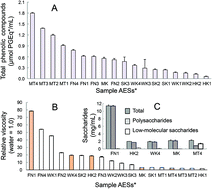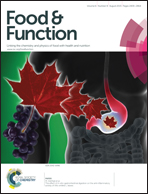Induction of the superoxide anion radical scavenging capacity of dried ‘funori’ Gloiopeltis furcata by Lactobacillus plantarum S-SU1 fermentation
Abstract
To understand the beneficial properties of edible algae obtained from the north-eastern (Sanriku) Satoumi region of Japan, the antioxidant properties of hot aqueous extract solutions (AES) obtained from 18 dried algal products were determined. The samples included 4 Ceratophyllum demersum (matsumo), 5 Undaria pinnatifida (wakame), 5 Laminaria japonica (kombu), and 2 each of Gloiopeltis furcate (funori) and G. tenax (funori). Of these products, the total phenolic content and Fe-reducing power were highest in matsumo. On the other hand, the polysaccharide content, viscosity, and superoxide anion radical (O2˙−)-scavenging capacity were highest in funori. Lactobacillus plantarum S-SU3, isolated from the intestine of Japanese surfperch, and Lb. plantarum S-SU1, isolated from salted squid, could ferment the AES of matsumo and funori, respectively. Although the Fe-reducing power of the matsumo solution was reduced due to fermentation, the O2˙−-scavenging capacity of the funori solution was increased by fermentation. Furthermore, the fermented funori suspension protected Saccharomyces cerevisiae, a live cell model, against H2O2 toxicity. These results suggest that the fermented funori is a promising functional food material that is capable of protecting against reactive oxygen species.


 Please wait while we load your content...
Please wait while we load your content...